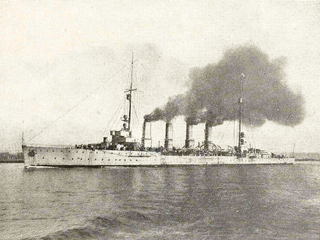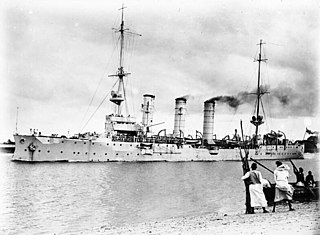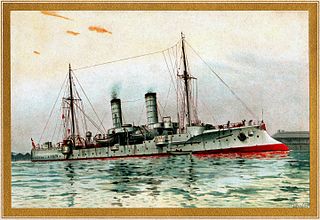
The Bayern class was a class of four super-dreadnought battleships built by the German Kaiserliche Marine. The class comprised Bayern, Baden, Sachsen, and Württemberg. Construction started on the ships shortly before World War I; Baden was laid down in 1913, Bayern and Sachsen followed in 1914, and Württemberg, the final ship, was laid down in 1915. Only Baden and Bayern were completed, due to shipbuilding priorities changing as the war dragged on. It was determined that U-boats were more valuable to the war effort, and so work on new battleships was slowed and ultimately stopped altogether. As a result, Bayern and Baden were the last German battleships completed by the Kaiserliche Marine.

SMS Frankfurt was a light cruiser of the Wiesbaden class built by the German Kaiserliche Marine. She had one sister ship, SMS Wiesbaden; the ships were very similar to the previous Karlsruhe-class cruisers. The ship was laid down in 1913, launched in March 1915, and completed by August 1915. Armed with eight 15 cm SK L/45 guns, Frankfurt had a top speed of 27.5 knots and displaced 6,601 t at full load.

SMS Wiesbaden was a light cruiser of the Wiesbaden class built for the Imperial German Navy. She had one sister ship, SMS Frankfurt; the ships were very similar to the previous Karlsruhe-class cruisers. The ship was laid down in 1913, launched in January 1915, and completed by August 1915. Armed with eight 15 cm SK L/45 guns, Wiesbaden had a top speed of 27.5 knots and displaced 6,601 t at full load.

SMS Stralsund was a Magdeburg-class light cruiser of the German Kaiserliche Marine. Her class included three other ships: Magdeburg, Breslau, and Strassburg. She was built at the AG Weser shipyard in Bremen from 1910 to December 1912, when she was commissioned into the High Seas Fleet. The ship was armed with a main battery of twelve 10.5 cm SK L/45 guns and had a top speed of 27.5 knots.

The Derfflinger class was a class of three battlecruisers of the Imperial German Navy. The ships were ordered for the 1912–13 Naval Building Program of the German Imperial Navy as a reply to the Royal Navy's two new Lion-class battlecruisers that had been launched a few years earlier. The preceding Moltke class and the incrementally improved Seydlitz represented the end of the evolution of Germany's first generation of battlecruisers. The Derfflinger class had considerable improvements, including a larger primary armament, all of which was mounted on the centerline. The ships were also larger than the preceding classes. The Derfflinger class used a similar propulsion system, and as a result of the increased displacement were slightly slower.

The Roon class was a pair of armored cruisers built for the German Kaiserliche Marine in the 1900s. The two ships of the class, Roon and Yorck, closely resembled the earlier Prinz Adalbert-class cruisers upon which they were based. The Roon class incorporated slight incremental improvements, including a pair of extra boilers. The ships were easily distinguished from their predecessors by the addition of a fourth funnel. Though the additional boilers were meant to increase the ships' speed, both vessels failed to reach their designed top speed. In addition, the ships had comparatively light armament and thin armor protection, so they compared poorly with their foreign contemporaries, particularly the armored cruisers of their primary opponent, the British Royal Navy.

The Scharnhorst class was the last class of traditional armored cruisers built by the German Kaiserliche Marine. The class comprised two ships, Scharnhorst and Gneisenau. They were larger than the Roon-class cruisers that preceded them; the extra size was used primarily to increase the main armament of 21 cm (8.2 inch) guns from four to eight. The ships were the first German cruisers to reach equality with their British counterparts. The ships were named after 19th century Prussian army reformers, Gerhard von Scharnhorst and August von Gneisenau.

The Cöln class of light cruisers was Germany's last class commissioned before her defeat in World War I. Originally planned to comprise ten ships, only two were completed; Cöln and Dresden. Five more were launched, but not completed: Wiesbaden, Magdeburg, Leipzig, Rostock and Frauenlob, while another three were laid down but not launched: Ersatz Cöln, Ersatz Emden and Ersatz Karlsruhe. The design was a slightly modified version of the preceding Königsberg class.

The Königsberg class was a group of four light cruisers built for the German Imperial Navy. The class comprised four vessels: SMS Königsberg, the lead ship, SMS Nürnberg, SMS Stuttgart, and SMS Stettin. The ships were an improvement on the preceding Bremen class, being slightly larger and faster, and mounting the same armament of ten 10.5 cm SK L/40 guns and two 45 cm (17.7 in) torpedo tubes.

The Königsberg class of light cruisers was a group of four ships commissioned into Germany's Kaiserliche Marine shortly before the end of World War I. The class comprised Königsberg, Karlsruhe, Emden, and Nürnberg, all of which were named after light cruisers lost earlier in the war. The ships were an incremental improvement over the preceding Wiesbaden-class cruisers, and were armed with a main battery of eight 15 cm (5.9 in) SK L/45 guns and had a designed speed of 27.5 knots.

SMS Rostock was a light cruiser of the Karlsruhe class built by the German Kaiserliche Marine. She had one sister ship, SMS Karlsruhe; the ships were very similar to the previous Magdeburg-class cruisers. The ship was laid down in 1911, launched in November 1912, and completed by February 1914. Armed with twelve 10.5 cm SK L/45 guns, Rostock had a top speed of 28.5 knots and displaced 6,191 t at full load.

The Karlsruhe class of light cruisers was a pair of two ships built for the German Imperial Navy before the start of World War I. The ships—SMS Karlsruhe and Rostock—were very similar to the previous Magdeburg-class cruisers, mounting the same armament and similar armor protection, though they were larger and faster than the earlier ships. Both vessels were laid down in 1911, and launched one day apart, on 11 and 12 November 1912. Karlsruhe joined the fleet in January 1914, but fitting out work lasted slightly longer on her sister; Rostock was commissioned the following month.

The Magdeburg class of light cruisers was a group of four ships built for the Imperial German Navy. The class comprised SMS Magdeburg, the lead ship, Breslau, Strassburg, and Stralsund. All four ships were laid down in 1910 and were completed by the end of 1912. They were armed with a main battery of twelve 10.5 cm guns, though over the course of their careers, Breslau, Strassburg, and Stralsund were rearmed with more powerful 15 cm guns. They displaced 4,570 t at full load and were rated at a top speed of 27.5 knots, though all four vessels exceeded that figure on trials.

The Pillau class of light cruisers was a pair of ships built in Germany just before the start of World War I. The class consisted of SMS Pillau and Elbing. The ships were initially ordered for the Imperial Russian Navy in 1912, and were built by the Schichau-Werke shipyard in Danzig. After the outbreak of World War I, however, the German Kaiserliche Marine confiscated the ships before they were completed. The ships were similar in design to other German light cruisers, although they lacked an armored belt. They were the first German light cruisers to be equipped with 15 cm SK L/45 guns, of which they carried eight. The two ships had a top speed of 27.5 knots.

The Graudenz class of light cruisers was a class of two ships built for the Imperial German Navy. The class comprised SMS Graudenz and SMS Regensburg. The ships both were laid down in 1912, launched in October 1913 and April 1914 and commissioned in August 1914 and January 1915, respectively. They were armed with a main battery of twelve 10.5 cm (4.1 in) guns, though over the course of their careers, they were rearmed with seven more powerful 15 cm (5.9 in) guns. They displaced 6,382 t at full load and were rated at a top speed of 27.5 knots

SMS Graudenz was the lead ship of her class of light cruisers. She had one sister ship, SMS Regensburg. The ship was built by the German Kaiserliche Marine in the Kaiserliche Werft shipyard in Kiel, laid down in 1912 and commissioned into the High Seas Fleet in August 1914, days after the outbreak of World War I. She was named for the then-German town of Graudenz. The ship was armed with a main battery of twelve 10.5 cm SK L/45 guns and had a top speed of 27.5 knots.

The Gazelle class was a group of ten light cruisers built for the Imperial German Navy at the turn of the 20th century. They were the first modern light cruiser design of the Imperial Navy, and set the basic pattern for all future light cruisers in Imperial service. The design of the Gazelle class attempted to merge the fleet scout with the colonial cruiser. They were armed with a main battery of ten 10.5 cm (4.1 in) guns and a pair of torpedo tubes, and were capable of a speed of 21.5 knots.

The Bremen class was a group of seven light cruisers built for the Imperial German Navy in the early 1900s. The seven ships, Bremen, Hamburg, Berlin, Lübeck, München, Leipzig, and Danzig, were an improvement upon the previous Gazelle class. They were significantly larger than the earlier class, and were faster and better armored. Like the Gazelles, they were armed with a main battery of ten 10.5 cm SK L/40 guns and a pair of torpedo tubes.

The Kolberg class was a group of four light cruisers built for the German Imperial Navy and used during the First World War. The class comprised four vessels: SMS Kolberg, the lead ship, Mainz, Cöln, and Augsburg. The ships were built between 1908 and 1910, and two, Kolberg and Augsburg, were modernized in 1916–1917. The ships were armed with a main battery of twelve 10.5 cm SK L/45 guns and had a design speed of 25.5 knots. The first three ships were assigned to the reconnaissance forces of the High Seas Fleet; Augsburg was instead used as a torpedo and gunnery training ship.
SMS Stuttgart was a Königsberg-class light cruiser of the Kaiserliche Marine, named after the city of Stuttgart. She had three sister ships: Königsberg, Nürnberg, and Stettin. Stuttgart was laid down at the Imperial Dockyard in Danzig in 1905, launched in September 1906, and commissioned in February 1908. Like her sisters, Stettin was armed with a main battery of ten 10.5 cm (4.1 in) guns and a pair of 45 cm (18 in) torpedo tubes, and was capable of a top speed in excess of 25 knots.


















